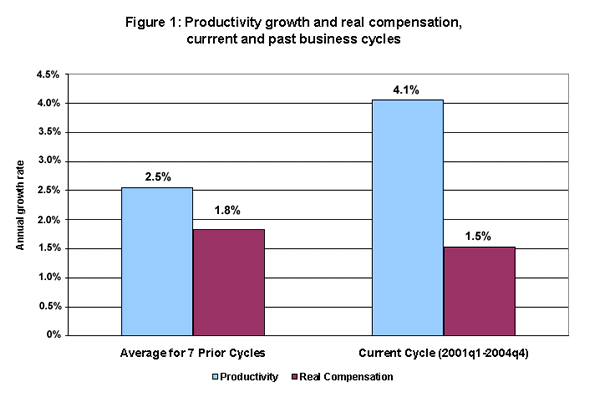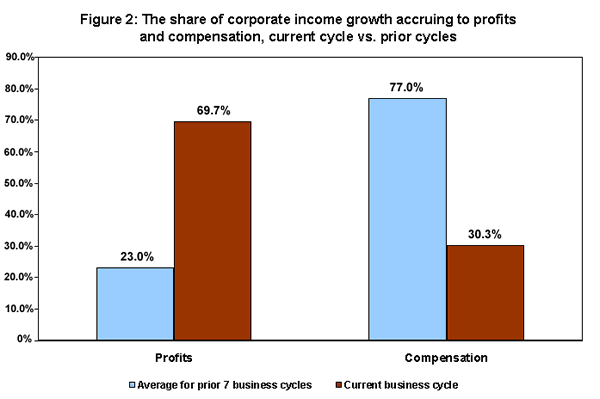See Snapshots Archive.
Snapshot for April 21, 2005.
Productivity growth and profits far outpace compensation in current expansion
One of the most impressive aspects of the current U.S. economy is the acceleration of productivity growth (that is, the increased output of goods and services per hour worked) that has prevailed since the mid-1990s. Between 1995 and 2000, hourly output grew by 2.5% per year, about one percentage point faster than in the prior 20 years. Lately, as Figure 1 shows, productivity growth has accelerated further, growing at an annual pace of 4.1%. Although this recent pace of productivity growth is probably not sustainable, it seems reasonable to expect that productivity growth will remain at or above the higher levels established in the mid-1990s.

Economists assume that faster productivity growth generates higher living standards through higher average wages. The problem is that only a small proportion of the increase in productivity growth since early 2001 has flowed to wages and compensation, implying that working families are not benefiting much from this improved output per hour. Figure 1 shows that, while productivity has grown 4.1% annually in the current business cycle, starting in early 2001, compensation growth has only been at a 1.5% annual rate. In other words, compensation has grown only 37% as fast as productivity.
It is not unusual for compensation to grow more slowly than productivity in such periods, as firms often rebuild their profit margins during recoveries before they take on higher labor costs. But the gap has typically been much smaller than it is today: over seven prior business cycles, compensation grew by 1.8% per year, on average, or 72% as much as the 2.5% annual productivity growth in these earlier cycles.
Also worth noting is that, while real compensation growth has been positive, this is largely the result of the increase in employers’ benefit costs (such as higher health insurance premiums). Furthermore, because of rising income inequality, the typical worker is doing far worse than average. Wages have lagged inflation for many workers in recent months (for more analysis of this trend, see JobWatch or the EPI briefing paper Less Cash in Their Pockets).
With compensation lagging productivity, and wages lagging prices, where is the added income growth going? As Figure 2 shows, profits have soared since the recession, creating a historically unique pattern. Over prior business cycles, profits (including interest income) have accounted for 23% of the growth in corporate-sector income, on average, with total compensation accounting for the remaining 77%. In the current business cycle, the distribution is almost reversed: profits have claimed nearly 70% of total growth in the corporate sector, while increases in compensation (from increased employment and higher hourly compensation) have received just over 30% of total income growth.

During the latter 1990s, wages and compensation generally increased in step with productivity growth, as tight labor markets ensured that workers throughout the income scale had the necessary bargaining power to claim their fair share of the income generated by growing output. Today’s faster productivity growth surely has the potential to raise working families’ living standards. But as long as growth continues to be so inequitably distributed, living standards will continue to flounder.
Technical Note:
Productivity and real hourly compensation are measured in the nonfarm business sector. The shares of total income growth going to capital income (profits and interest) and compensation (wages and salaries and benefits) are measured for the corporate sector, which comprises about two-thirds of domestic national income (which also includes the government/nonprofit and proprietary sectors for which capital and labor income shares are either not well-measured or inappropriate). See The State of Working America 2004/2005 for details.
This Snapshot was written by Lawrence Mishel and Jared Bernstein with research assistance by Yulia Fungard.
